#animation principles term one
Explore tagged Tumblr posts
Text
unfortunately i can never truly get on with my mother's husband due to a terrible disease called Leftist Infighting
#gemitus#purposely came back to edit in the future to minimise someone reading this#basically he was given something with meat in it and cared more about his 30 year long veganism streak than the wasting of food#which in my opinion is a misguided intention of veganism?#then i got pissed off at him and he lectured me about utilitarianism and deontology#and that hes probably saved more animals than hes killed. which fine. but why not 'save' one more#or at least dont waste one. like its not a punch card kind of deal#basically he said he cared more about the long term consequences of his actions#then he suggested going to mcdonalds at which point i explained the palestine situation#and we went anyway.#then today he said every corporation is part of the capitalist machine so we can never make a Truly good choice#and its like we didnt have to go to mcdonalds. be for real#i do feel a bit bad for sort of bullying my brother into trying to cancel his order which got him yelled at by our mum#umm. yeah. essentially its a philosophical question of how you intend to deal with consequences of your actions#when living in a capitalist Society that we have opposing viewpoints on#and even though nobody knows it ive always stuck to my principles when it comes to my viewpoint
0 notes
Text
ik this is known but no successful settler colony has reached relative "internal stability" without genocide. north america is the first example of this that comes to mind: during the early years all up to the 19th cent., wars and attacks between native americans and settlers were frequent. and yes, while the settler armies were more well armed and more powerful, the native americans were a great force against the european invasions and did cause casualties among white populations, "including civillians", and halted expansion and development for many of the colonies.
this was met in 2 ways:
federal programs sponsored by the colonial states (violent deculturation, seperation from families through residential & boarding schools, expulsion from ancestral lands and destruction of the indigenous identity)
and unofficial, "individual" settler and enlistee actions of massacres upon indigenous populations. these events obviously were never prosecuted because they worked in tandem with the colonial powers, supported and encouraged by them.
the extermination of the american indigenous people wasn't just a facet of american success but the foundation of it. if they weren't subject to the genocide, the wealth and vast land in north america wouldn't have reached the white populations and the continent would be unrecognizable today, with canada and the united states not slightly as globally influencial as they are today. imagine a usa reliant on tourism.
and ik this is all elementary level information, but israel mirrors this entire process in eery similarity, with ancient, ancestral lands seized from palestenians exploited and destroyed for capital gains following violent expulsions (the nakba created israel). palestinians remaining within the israeli border endure lynchings and attacks by settlers as well as repression and persecution under federal law. israel was founded on the same colonialist principles that america and other european settler colonies (algeria, mozambique, kenya) were: their survival just depended on how far they would go to destroy the indigenous population.
what im dreading is that israel is on course to go further and proceed with that destruction. we are currently is a uniquely horrifying moment: 2,600 dead palestenians and 6,000 in hospitals with 0 supplies and 0 power - and the ground assault following the impossible evacuations is looming. the massacres about to sweep palestinian lands with the gifting of the ten thousand rifles to settlers. the unprovoked, unwarned and constant airstrikes. the monolithic, hysteric nature of mainstream western media. the army's sentiment of hunting animals. the global unrepentant backing. the repeated promise of complete victory.
what would complete victory mean? you cannot quell palestenian resistance without exterminating palestine. the palestenian people are a tortured people, hungry, radicalized simply from their day to day life: not one gazan hasn't watched corpses being pulled from the rubble, not one gazan doesn't have murdered family, not one gazan doesn't have something to mourn. their friends and family disappear or lose limbs on the daily now, building on grief from the previous 7 decades deep destruction. the homesickness is constant. the sounds of explosions is never far. of course there would be resistance movements, of course there would be revenge attacks, of course it will be bloody, because no humans in the world could silently endure these conditions. if hamas was entirely destroyed tomorrow, the next generation of palestinian youths would simply form another. for a complete, permanent victory, you would need to raze palestine.
this is why i balk at people hoping for coexistence. coexistence goes against the very founding strategy of israel. it goes against every principle and long term plan israel has for itself. israelis themselves do not want coexistence, they want gaza flattened and the west bank annexed, they want palestine destroyed and the palestenian people extinct. any sympathy with israel is a transgression on humanity.
#palestine#gaza#anti zionisim#this is a very base level knowledge of native american history by the way im sorry
3K notes
·
View notes
Text
Writing Notes: Magic Systems
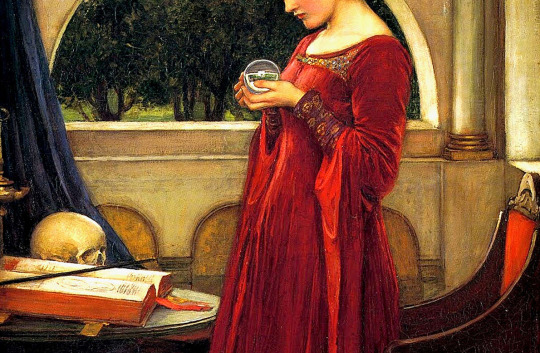
Magic - change wrought through unnatural means
Most fantasy can be placed along a spectrum where there are 3 main points: soft magic at one end, hard magic at the other, and a middle ground between the two.
Soft Magic
Magic that is not well-defined for the reader.
Generally, we don’t understand where the magic comes from, who can use it, or what its limitations are.
Readers can see this type of magic being used.
But they can never anticipate when magic will be used in the plot because they can’t begin to guess how it works.
You can’t break a rule if the rules don’t exist!
Most stories that feature this system will have the magic users be secondary characters, allowing them to avoid explaining exactly how the magic works.
It’s also argued that without knowing everything about the magic, it tends to hold more wonder and excitement for readers.
Hard Magic
Has very rigid boundaries.
Readers know where the magic comes from, how it’s used, who uses it, and what its boundaries and limitations are.
We know the limitations of the characters and can understand why they can’t simply magic themselves out of any particular challenge.
Stories with hard magic systems do not need to avoid the main character being a magic-wielder, as they have the capacity to explain to the reader what is going on.
A lot of writers this system because it gives them very explicit guidelines to follow in their plot and creates some more satisfying pay-offs for readers.
The Middle Ground
The meeting point between the soft and hard systems.
We might understand a bit about the way the magic works, but not all our questions are answered.
While most of the content adheres to rules, these rules aren’t fully explored.
This system relies on the reader’s suspension of disbelief.
The main character can be a magic-wielder or not, and it’s up to the writer to determine when magic will be used in terms of plot.
How to Choose a System
You can and should use these guiding principles to build your magic system. Remember that you don’t have to choose one or the other. Your system can draw from aspects of both. Just stay aware of the weaknesses of the path you choose, and ensure you utilize its strengths.
Use a hard magic system if:
You are going to use magic to solve problems
Your audience is accustomed to the tropes of hard magic
You are okay with jumping through hoops to expand your system
Your magic doesn’t convey a theme
Use a soft magic system if:
You want to convey a theme through magic
You want to create a sense of wonder
You want the ability to expand easily
You want to be accessible to a broader audience
Your magic won’t regularly be used to solve problems
Branches of Magic
Like most writing processes, there isn’t really a correct place to begin designing a magic system. A common, and efficient, place to start, however, is by choosing what type of magic system(s) you wish to employ, such as:
Nature-based magic: water, earth, fire, air, and everything in between
Divination magic: see beyond sight and peer through time and space
Conjuring magic: move objects through space over any distance
Psychic magic: master the world of the mind
Life and death magic: tap into the very forces of life, death, and un-death with this surprisingly versatile collection
Animal- or creature-exclusive magic: some creatures just do it better
Magitech systems: the blurring lines of sorcery and science give magic a next-gen, high-tech flair
Eclectic magic: it doesn’t have to be “real” magic to have a real effect
Uncommon magic systems: the unsung heroes of fantasy magic
AALC Method
How to create your own magic system using the AALC (Appearance, Abilities, Limits & Cost) Method
Appearance
What the magic looks like
Makes the world feel more exotic
Can cause problems for characters but cannot solve them
Usually tied to a character arc
Abilities
What the magic does
Points calculated based on magical effect, range, number of people affected, and duration
Characters have a finite amount of fuel (mana) to use abilities
More powerful abilities require more fuel
The fuel does not have to be overt for the audience to understand
If points not overt, cannot solve conflicts unless a cost system is added
Limits
Unlimited uses of magical abilities
Abilities stratified in codified levels defined by their limits
The more the levels' abilities and limits are known by the audience, the more they can be used to solve conflicts
Focused on clever uses of abilities against stronger foes
Cost system can be added to enhance dramatic moments
Cost
Costs must be greater than or equal to abilities to make them dramatically satisfying
Costs can include time, exhaustion, materials, sanity, morality, etc.
Adds dilemma to magic by forcing characters to make choices
The greater the character's sacrifice, the more audience satisfaction at conflict resolution

Each system builds on the previous ones, so that Cost Systems use all four, while Point Systems only care about Abilities and Appearance.
Multiple systems can exist within the same story, and systems can harden over the course of the story.
The Force, for instance, has been a Soft, Point, Level, and Cost System depending on who wrote it at the time.
SOFT SYSTEMS (Appearance Only)
Window Dressing - magic for secondary characters; can instigate conflict but cannot solve it; e.g., Gandalf
Soft Villain - No explanation or upper limits needed; makes villains more powerful to make heroes greater underdogs; e.g., The Emperor
Chosen One - Unknown power keeps hero safe throughout story; can be considered plot armor unless earned through character arc
Sort Hero Incomplete - Curse or positive ability the character cannot control; hero still learning limits of ability at story's end; powers and arc continued in next adventure
Soft Hero Complete - Hero embraces ability to complete arc and solve main conflict; magic must become harder in subsequent adventures
POINT SYSTEMS (Appearance + Abilities)
Points Opaque - Non-explicit reservoir of energy fuels powers; cannot solve main problems without cost option because characters finding hidden energy reserve feels like deus ex machina
Points Hard - Both abiliites and points system must be explicit like in video games; becomes about resource management; easy to understand but takes sense of wonder out of magic
LEVEL SYSTEMS (Appearance + Abilities + Limits)
Soft Level Static - Unchanging power without upper limits; cannot solve conflicts because feels repetitive; power must be used cleverly; e.g., Wolverine's healing factor
Soft Level Advancing - Increased powers or new powers with unknown limits; cannot solve conflicts unless tied to a character arc like Soft Hero Complete, at which point "unlocks" new abilities
Hard Level Static - Unchanging abilities with clear-cut limits; can solve conflicts so long as setup is properly seeded, usually resulting in sacrifice; e.g., Genie
Hard Level Advancing - Well-established abilities with limits; can solve conflicts based upon clever uses of abilities, usually against stronger foes; e.g., Airbender
COST SYSTEMS (Appearance + Abilities + Limits + Cost)
Static Cost - Well-established cost remains consistent for each use of ability; can solve conflicts since based on personal sacrifice
Cost Fluctuating - Costs change based upon dramatic need; costs must be greater than or equal to ability; possible costs include lost time, money, sanity, health, memory, life, morality, etc.
Sources: 1 2 3 4 5 6 ⚜ Writing Notes & References Writing Notes: Magic System ⚜ Fictional Items; Poisons ⚜ Fantasy
#writing reference#fantasy#magic system#writeblr#dark academia#spilled ink#fiction#creative writing#novel#writers on tumblr#literature#writing prompt#poets on tumblr#poetry#writing prompts#light academia#lit#writing tips#writing inspiration#writing ideas#john william waterhouse#writing resources
507 notes
·
View notes
Text
6B4T
Lately there has been talk about 4B and so I wanted to bring up 6B4T which grew from the South Korean 4B movement, and specially the 6B4T movement as it is practiced by our Chinese sisters. Before that however differences between the both are as followed:
4B
No sex with men
No giving birth
No dating men
No marriage with men
6B4T
Includes the original commandments of 4B and adds the following:
Don’t buy products from misogynistic brands
Support single women/women that have chosen to be celibate
Reject the corset (rejecting toxic beauty standards)
Reject idol culture (as in male-worship and idolization of entertainment figures this ALSO includes rejecting idol culture for female kpop idols/entertainers)
Reject otaku culture (rejecting misogynistic anime culture)
Reject religion
(**You may see 6B4T referred to as 10bt to avoid censorship as CN social media sites are heavily monitored by government censors, even outside of CN social media CN sisters will still refer to it as 10bt because 6b + 4t = 10bt)
Now that there's a basic understanding... I wanted to talk about some of the differences that the CN 6B4T movement has compared to what I usually encounter in English speaking radfem circles. Please note that this is my own experience and as with any political movement there can a myriad of women that agree and disagree (except on the 6B4T principles as a whole, those are rock solid for them haha.)
I was first aware of this movement around 2020 and have been following women on twitter/x since then that follow these beliefs. All of this has been gathered from tweets by 6B4T users on twitter/x + interactions with them. I am not a CN speaker and have used translation apps to piece together details on the 6B4T movement and have cross referenced this with some of the writings I can find in English about this and the conversations that I have had with some of the 10bt sisters that were willing to interact with me.
I do not feel comfortable just singling out specific accounts for people to look up on twitter but anyone that wants to do their own research can search the keywords on twitter 6B4T or 10bt and go under the "People" filter to populate accounts of CN women that have 6B4T and/or 10bt in their bio.
One thing that I want to talk about right away - the term donkey. It will come up quite often when you search 10bt accounts and is used to describe women that are perpetuating patriarchy because they "carry the patriarchy without protest and allow themselves to be exploited." (This includes married women.) 10bt sisters DO NOT have an emphasis on educating women that perpetuate patriarchy. You can find sayings such as:
"Feminism is like being given a weapon to support yourself with, do not use it to commit suicide by having a complex of saving donkeys"
“Don't do donkey work for donkeys".
“Don’t get derailed by women support women, leave the donkeys alone.”
Which leads me to the next point - 10bt sisters are for empowering women independently. There is obvious acknowledgement of bonds and relationships between women but the general feeling is more to focus on the individual self, connections are based solely on shared interests and can be let go of as needed. (I have also seen discussions of letting go of romantic ties not just for straight sisters but for lesbian sisters as well.) Sentiments such as "focusing on oneself is a foundation for a happy life" "All thoughts and ideologies cannot be separated from down to earth efforts and dedication" are plenty. Really a focus away from "altruistic" causes so to speak
And on that note: anti veganism. 10bt sisters in general are adamant that 6B4T principles should only include tackling patriarchy and not have other causes added to it. Anti veganism sentiment also seems to stem from certain aspects in CN culture of serving smaller portions to young girls and discouraging them to eat meat as opposed to men. The focus on improving one's self from before also shows up here: "Women need strength to overthrow patriarchy, only then should we focus on improving the lives of animals."
Some 10bt sisters are also very open about criticism and believe women that openly identify with the 10bt movement should be prepared to have their posts critiqued, and while some will debate this... one of the things that is absolutely non negotiable is that actions MUST back up words. There’s lots of debates that go on in the 10bt movement but the bare minimum is that if you follow 6B4T then you must follow its core beliefs otherwise what are you here for? There is a huge disdain for those that say they belong to this movement but don’t follow its beliefs.
With that being said, how do the 10bt sisters feel about 4B taking off in the states? Well…
“4B grew into 6B4T and they only dared to do half of the movement? It’s disappointing.”
“At this point in time, it is crazy to deliberately go back and start from 4B. You have someone’s shoulder to stand on but you won’t take it.”
“4B: No marriage, no giving birth , no sex, no dating. Doesn't that mean they are still serving as donkeys: supporting idols and otaku, believing in religion, using pornographic content, and consuming misogynistic brands... It really makes one recognize by a glance what stupid things they are still doing.”
“I don't understand how this kind of castration of the feminist movement came about.”
Is some of the general consensus on twitter/x.
Two more things I will add here before I wrap this up:
I have seen a post in English about other principles to follow such as 5B, 7B or 8B. I am not aware of what these principles are and could not find a CN source to confirm this so if 5B, 7B and 8B do exist, I do not believe it originated from the CN movement.
There is also the concept of icing men out aka if a man comments on your social media posts immediately delete the comment EVEN if it is a comment in agreement. For this while I also could not find a specific CN source for the 10bt sisters, it feels like it is just natural to not interact with men. I have yet to see debates on whether someone can be part of 10bt and still have a boyfriend, husband, etc since the answer will always be a resounding NO. (And on this note… if you are curious about attitudes towards male family members.. rejection of filial piety is something that is very agreed upon. I would recommend first learning what filial piety entails in CN culture as whole if there is curiosity about this.)
I will wrap this up with one of my favorite concepts I have encountered from our 10bt sisters:
“When one woman keeps house*: five women are trapped: herself, daughter, mother, sister-in-law, and female coworkers”
[*keeps house meaning - “when one woman marries…”]
If there are sisters out here who are involved with this or have more info to add please feel free to do so! Also would love to get in touch with any that know more on the CN 10bt movement.
173 notes
·
View notes
Text
🌅 Lucifer Deity Guide 🌅

Note: This is inspired by both my own experiences with Lucifer and the information I read on @scarletarosa's blog and her devotional guide to him. Please go read that one too!!
The divine rebel, Lucifer is the light of truth and divine wisdom; an ancient light which shines through the darkness, representing illumination. He is the driving force of innovation, liberation and transformation. According to Scarletarosa, who actively works with Lucifer and was told this by him, he was the first-born god of the Universe created by the supreme deity, the Source. He is so incredibly ancient and beautiful. Lilith was created to be his counterpart, the Queen of Heaven. However, Jehovah took the throne of heaven from Lucifer and cast him and his followers into hell. Most of them lost their connection to heaven and their energy became dark and intense. Jehovah claimed the throne of heaven and set himself up as the one true god, manipulating humans into betraying their original deities. Thus, Lucifer became the King of Hell and has been scorned by Christians for millenia.
God of: Illumination, Light, Darkness, Change, Rebirth, Challenges, Innovation, Logic, Truth, Knowledge, Wisdom, Strategy, Persuasion, Revolution, Luxury, Pleasure, Freedom, The Arts and The Morning Star (“Morning Star” is another name for the planet Venus)
Symbols: Sigil of Lucifer, The Morning Star, Violins and Fiddles (instruments traditionally associated with him)
Plants and Trees: Rose, Belladonna, Mulberry, Patchouli, Myrrh, Min, Tobacco, Marigold, Lilies, Hyacinth, Sage
Crystals: Amethyst, Black Obsidian, Onyx, Garnet, Selenite, Rose Quartz
Animals: Black Animals in general, Dragons, Snakes, Owls, Eagles, Ravens, Crows, Rams, Foxes, Pigs, Bats, Rats, Moths, Swans
Incense: Rose, Frankincense, Patchouli, Myrrh
Colors: Black, Red, Silver, Emerald Green, Gold
Tarot: The Devil
Planets: The Morning Star, Venus
Day: Monday and Friday
Consort: Lilith
Children: Naema, Aetherea and many others

How was he traditionally worshipped?
There is not much to say about how Lucifer was historically worshiped seeing as he wasn’t worshiped at all for a large chunk of human history. He seems to have been worked with in some capacity according to the Gesta Treverorum, written in 1231, which is where we first see the term Luciferian being used to refer to his worship. This was by a woman named Lucardis for a religious circle, who was said to lament to Lucifer in private and prayed to him. However, the term Luciferians was later applied to basically any groups Christians didn’t like and wanted to fight, as one might expect. However, the modern Luciferian movement also sheds light on how Lucifer is worshiped. For Luciferians, enlightenment is the ultimate goal. Their basic principles highlight truth, freedom of will and fulfilling one’s ultimate potential, and encourage the same in all of us. Traditional dogma is shunned because Luciferians believe that humans do not need deities or the threat of eternal punishment to know what is good and the right thing to do. All ideas are to be tested before being accepted, and even then one should remain critical because knowledge is fluid and ever-changing. Regardless of whether Luciferians view Lucifer as a deity or an archetype, he is a representation of ultimate illumination and exploration in the name of personal growth.
Epithets
Phanes
The Morning Star
Light-bringer
The First-born
Prince of Darkness
Son of Morning
The Glory of Morning
Lord of the Lunar Sphere
The First Light

Offerings
Red Wine, Whiskey (especially Jack Daniels), Champagne, Pomegranate Juice, Black Tea (especially earl grey), Chocolate (especially dark chocolate), Cooked Goat Meat, Venison, Apples, Pomegranates, Honey, Good Quality Cigars, Tobacco, Daggers and Swords, Silver Rings, Emeralds and Emerald Jewelry, Goat Horns, Black Feathers, Seductive Colognes, Red Roses, Dead Roses, Crow Skulls, Bone Dice, Devotional Poetry and Artwork, Classical Music (especially violin)
Devotional Acts
Acts of self-improvement, spiritual awakening and evolution, knowledge-seeking and dedication to spirituality ; Shadow Work ; Working to overcome your ego to become wiser ; Defending those in need ; Working to better yourself without being too self critical ; Fighting against tyranny and bigotry whenever you encounter it
Altar Decorations
Black or Red Candles, Snake and Dragon Figurines, His sigil, Roses, Fancy Chess Boards and Playing Cards, Silver Jewlery and ornaments, Black feathers, Goat horns

Appearance
For me Lucifer usually appears as a tall light-skinned man with long fiery red hair (so red it looks like it’s been dyed), a sophisticated face with a killer jawline, passionate eyes and dressed in a fancy black suit. From all my experiences with him and what I’ve heard from other followers, it seems Lucifer and most demons dress in full suits and tuxedos.
Personality
Lucifer is nothing if not charming. He’s a protector first and foremost - one that always works to help you better yourself, but a protector nonetheless. He feels like a protective older brother taking care of you while your parents are away. He is a very complex entity, deeply wise and eloquent. He is more serious than one might expect for a demon given their popular depictions in our culture as chaotic forces of evil, but Lucifer is full of courage and love. I often feel him with me even when I’m not doing things related to him. He is proud of his follower’s accomplishments and congratulates them on a job well done, though he also reminds them that the job is never truly over. Growth is constant. Lucifer is the epitome of growth, blunt and gentle at the same time, telling you what you need to do and giving you space to figure out how to do it.
Lucifer values resilience, the pursuit of self-betterment, intellectualism, courage, open-mindedness and responsibility in individuals and wants to see his followers develop these qualities. He is constantly rooting for you to reach your full potential. He won’t hold your hand the entire way, but he will help you take steps in the right direction. Lucifer, like all deities, is different for everyone and will adjust his approach depending on your needs.
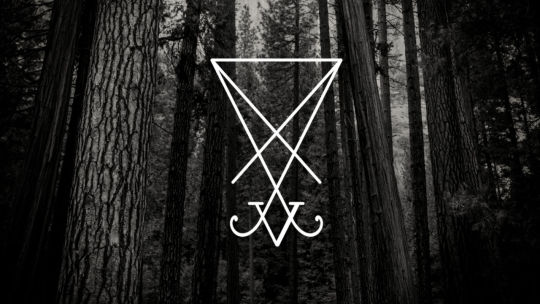
^ The Sigil of Lucifer
#deity work#witchblr#witch tips#spirit work#lucifer deity#lucifer devotee#luciferian#luciferian witch#lucifer morningstar
833 notes
·
View notes
Text
Nasal COVID-19 vaccine halts transmission - Published July 31, 2024
Study in hamsters indicates vaccines targeting nose, mouth may be key to controlling spread of respiratory infections
A nasal COVID-19 vaccine blocks transmission of the virus, according to an animal study by researchers at Washington University School of Medicine in St. Louis. The findings suggest that vaccines delivered directly to the nose or mouth could play a critical role in containing the spread of respiratory infections.
The lightning-fast development of COVID-19 vaccines just months after the virus appeared was a triumph of modern science and saved millions of lives. But for all the good they did in reducing illnesses and deaths, the shots were unable to end the pandemic because of one notable weakness: They couldn’t stop the spread of the virus.
A new study by researchers at Washington University School of Medicine in St. Louis indicates that next-generation vaccines that target the virus’s points of entry — the nose and mouth — may be able to do what traditional shots cannot: contain the spread of respiratory infections and prevent transmission. Using a nasal COVID-19 vaccine based on Washington University technology, approved for use in India and licensed to Ocugen for further development in the U.S., the researchers showed that vaccinated hamsters that developed infections did not pass the virus on to others, breaking the cycle of transmission. In contrast, an approved COVID-19 vaccine that is injected failed to prevent the spread of the virus.
The findings, published July 31 in Science Advances, provide further evidence that so-called mucosal vaccines sprayed into the nose or dropped into the mouth may be the key to controlling respiratory infections such as influenza and COVID-19 that continue to circulate and cause significant illness and death.
“To prevent transmission, you need to keep the amount of virus in the upper airways low,” said senior author Jacco Boon, PhD, a professor of medicine, of molecular microbiology and of pathology & immunology. “The less virus that is there to begin with, the less likely you are to infect someone else if you cough or sneeze or even just breathe on them. This study shows that mucosal vaccines are superior to injected vaccines in terms of limiting viral replication in the upper airways and preventing spread to the next individual. In an epidemic or pandemic situation, this is the kind of vaccine you’re going to want.”
Developing vaccines that can control virus levels in the nose has proven challenging. Viruses such as influenza virus, SARS-CoV-2 (the virus that causes COVID-19) and respiratory syncytial virus (RSV) multiply rapidly in the nose and spread from person to person within a few days of initial exposure. Traditional injectable vaccines generate immune responses that can take a week to build to full strength and are much less potent in the nose than in the bloodstream, leaving the nose relatively unprotected against a fast-multiplying, fast-spreading virus.
In principle, a vaccine sprayed or dropped directly into the nose or mouth could limit viral reproduction and thereby reduce transmission by eliciting an immune response right where it’s needed most. But gathering evidence that mucosal vaccines actually do reduce transmission has proven tricky. Animal models of transmission are not well-established, and tracking person-to-person transmission is fiendishly complicated, given the number and variety of encounters a typical person has on any given day.
For this study, Boon and colleagues developed and validated a model for community transmission using hamsters and then used it to assess the effect of mucosal vaccination on the spread of SARS-CoV-2. (Unlike mice, hamsters are naturally susceptible to infection with SARS-CoV-2, making them the ideal laboratory animals for a transmission study.)
The researchers immunized groups of hamsters with laboratory versions of approved COVID-19 vaccines: the nasal iNCOVACC used in India or the injected Pfizer vaccine. For comparison, some hamsters were not immunized. After giving the vaccinated hamsters a few weeks for their immune responses to fully mature, the researchers infected other hamsters with SARS-CoV-2 and then placed the immunized hamsters with the infected hamsters for eight hours. This first step of the experiment mimics the experience of vaccinated people who are exposed to a person with COVID-19.
After spending eight hours rubbing shoulders with infected hamsters, most of the vaccinated animals became infected. Virus was found in the noses and lungs of 12 of 14 (86%) hamsters that had received the nasal vaccine, and 15 of 16 (94%) hamsters that had received the injected vaccine. Importantly, while most animals in both groups were infected, they weren’t infected to the same degree. Hamsters that had been nasally immunized had virus levels in the airways 100 to 100,000 times lower than those that had received the shot or had not been vaccinated. The study did not assess the animals’ health, but previous studies have shown that both vaccines reduce the likelihood of severe illness and death from COVID-19.
The second step of the experiment yielded even more striking results. The researchers took vaccinated hamsters that subsequently developed infections and placed them with healthy vaccinated and unvaccinated hamsters for eight hours to model transmission of virus from a vaccinated person to others.
None of the hamsters that were exposed to nasally vaccinated hamsters became infected, regardless of whether the recipient hamster had been vaccinated or not. In contrast, roughly half of the hamsters that were exposed to hamsters vaccinated by injection became infected — again, regardless of the recipient’s immunization status. In other words, vaccination through the nose — but not by injection — broke the cycle of transmission.
These data, Boon said, could be important as the world prepares for the possibility that avian influenza, currently causing an outbreak in dairy cows, might adapt to humans and trigger a flu epidemic. An injectable vaccine for avian influenza already exists, and a team of researchers at Washington University is working toward a nasal vaccine for avian influenza. That team includes Boon and co-author Michael S. Diamond, MD, PhD, the Herbert S. Gasser Professor of Medicine and one of the inventors of the nasal vaccine technology used in this paper.
“Mucosal vaccines are the future of vaccines for respiratory infections,” Boon said. “Historically, developing such vaccines has been challenging. There’s still so much we don’t know about the kind of immune response we need and how to elicit it. I think we’re going to see a lot of very exciting research in the next few years that could lead to big improvements in vaccines for respiratory infections.”
Study linked in the first link!
#covid#mask up#pandemic#covid 19#coronavirus#wear a mask#sars cov 2#still coviding#public health#wear a respirator
221 notes
·
View notes
Text
I finished rewatching Death Note. I always forget how short anime is, with episodes that aren't much more than 20 minutes when you skip the intro/outro.
I hadn't remembered how much of a sniveling wreck LIght was at the end of the show. There's something about the ending that makes it feel like it was written and directed by a different person, not that Light wasn't always a little weird and pathetic, and not that the show didn't consistently go out of its way to let us know what a piece of shit he was (particularly his absolute lack of loyalty or empathy to anyone, even aside from the megalomania). But he takes the loss like a loser, snot dripping from his nose, voice cracking, begging, and it's so pathetic that I almost felt a little sorry for him.
I've always found the Death Note to be a very interesting prompt, one of those hooks that's so good I'd want to watch it even if it was bad. But in writing something like Death Note, the author has to make decisions about what to show and what not to show, and also make decisions about how they're going to portray the public at large.
There are two big things that stand out for me.
One is that we never get someone arguing against Kira. We get people who are actively trying to hunt him down, but they're mostly not stopping to say "this is why what he's doing is wrong" except a few lines about how he has a childish sense of justice, which is never expounded upon. Kira, on the other hand, we hear a lot from, not just the megalomaniac stuff, but the notion that criminals must be punished, that this is what people desire in their hearts. I get the strong sense that L does not actually care and just views this as an interesting puzzle for him to solve, but for everyone else it's largely left as an exercise to the viewer, and even then, there are moments when some of our task force members come dangerously close to endorsement.
To the extent the show has an answer, it's that (to quote Kanye West) no one man should have all that power, or that Kira has crossed a lot of lines, but no one argues in favor of rehabilitation or clemency or just fundamental humanity. Kira seems to largely be killing prisoners, who have already been sentenced, and are wards of the state, and he says "this is what people want deep down, they will give you the politically correct answer but they actually want the criminal class to be obliterate", which ... there's no character who actually voices any opposition to through the whole series. And I find that weird, because yes, the show has its own answers in terms of how it plays out, but in a show filled with people possessed of immense conviction, most of the people in opposition to Kira are just intellectuals who don't actually give a shit about the ideological question.
(The one big moment when it comes to a head, IMO, is when Soichiro Yagami refuses to write Mello's name entirely because of his principled objection to killing someone. I thought this was great, and I wish the show had more of it.)
The other big thing is that we don't really get a viewpoint of the criminals, with a few exceptions. One is the is Yotsuba group, who are killing people with the Death Note, and the second is the (somehow still functional) mafia that Mello hangs out with. There's also one other scene somewhere after L's death where we see a criminal begging with the police not to have his name written down, and that's about it.
The naive view here is that the show really does believe in Criminals as being a part The Other, a different sort of human being who walk among us. The criminal class are described as rotten and evil, they're shown as grotesque and with exaggerated features or bestial characteristics, and they're generally leering and impulsive. There is no consideration of their humanity.
There's a more nuanced take here, which is that we have a criminal as one of our main cast, Light Yagami, along with everyone else who takes on the Kira mantle. So what is the show saying about criminality through how it portrays them? And here ... I don't know. I kind of don't think that it views them as criminals in the same way? When we look at the ways that Light kills, I genuinely do think that the show thinks that this is different from the way that a capital-C Criminals kill. It's reactionary rather than criminal in and of itself, a response to the injustices of the world rather than being in the same class as those injustices. Light is narratively exempted, and Misa is to. Which isn't to say that I think the show thinks highly of Light, it clearly doesn't, especially in its ending, but I almost think that in the end it Others him too (and also has Teru Mikami drawn in particularly 'evil' style, like a creepy deviant gremlin).
So I enjoyed the rewatch, but there are things that sit a little oddly with me as far as the central themes go. There's probably some discourse I should read that's come out since I first watched it in ... 2010 or whenever, but I think I'll give that a skip.
120 notes
·
View notes
Text
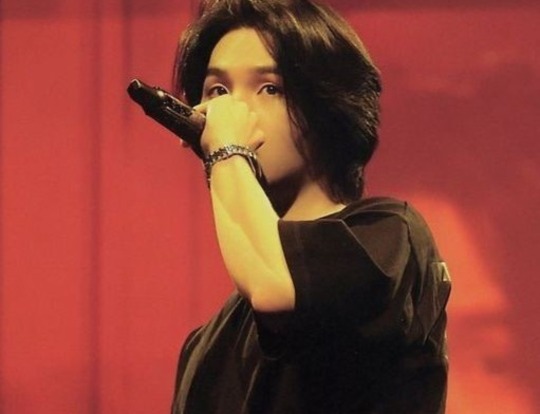
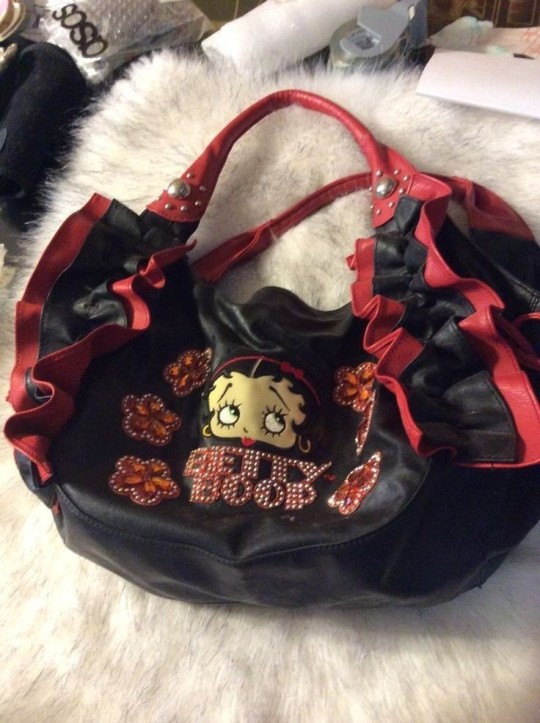
💌 She's an overachiever. "Pressure"? What pressure? ⋆₊˚⊹🔖
«───────── « ⋅ʚ♡��⋅ » ────────»
My second year of college is coming in hot guys. And I'm talking the 3rd of September, in TWO WEEKS TIME HOT.
But you already know your girl has BEEN locked in with her subliminals for the next term, cus I've had a whole thing going on since my first term to my second yk. so come a little closer so I can show yall what my game is on
p.s.a!! I am an animation and games art student, so most to all of my work is research and art based. And when I say most of my work is research based, I mean there is an ungodly amount of writing that is expected from the students and it's not even just the amount it's WHAT you write about that gets you the grade and how well your art conveys your ideas.
Also "Ex." = Example
╰┈➤ " My average college day experience as an art student/loass babe " click here!
«───────── « ⋅ʚ♡ɞ⋅ » ────────»
"What? Like it's hard?" At the top of her class, always ontop of her work, never slacking off, always locking in.
── .✦ ┆ 𖤐 ┆ ␥
|| Perfect focus, super attentive, always pays attention and makes notes. I am never afraid to ask for help or advice and I always receive the answers I need to understand the work; no room for confusion here.
|| Very strong, clear memory, perfect photographic memory.
|| Studies so much, it's my hobby, never underestimates myself or downplays my work, has always prioritised my work and has always understood the importance of doing work at home. Studying has never been a struggle for me because I don't struggle with discipline. I actually find so much fun and enjoyment doing homework. I always feel so productive and proud of myself whilst managing my time and looking at the amount I have done afterwards. Especially with the amount of validation and points I earn from teachers. It is always so satisfying seeing my high grades after a complete project. It's like a treat.
|| Creative genius, always brainstorms with words or loose sketches; not a single idea goes to waste. Research enthusiast, I could never shy away from making a thorough, detailed, and well planned out analysis, moodboard or mindmap. And multiple of them at that. I always know EXACTLY what to write and never wastes precious time and space yapping.
|| The life of an art student is exciting, fulfilling, flourishing, inspiring and strict. In the healthy way of course. My parents and teachers are always understanding of my burnouts and art block which are very rare thank god; and it's a good thing I have my closest friends to comfort me through my work. They are always so supportive, encouraging and honest with me as I am with them. We always travel together to the college (when I don't feel like being alone) and we always travel back home together. I mean we are our own personal friend circle so of course we buy snacks for each other and meet up for lunch; it's not even like we need to worry about price since we have more than enough on us. College is 100 times better when my best friends are with me, everything feels so comfortable with them
|| Perfect, cunty, and ideal artstyles. Always chooses the ones most appropriate for a certain design, and never forgets how to convey a certain look. I know, understand and draw human, animal, vehicle, clothing anatomy and terminology, enviromental composition, colour theory and terminology, the 12 principles of animation, the 7 fundamentals of art (Line, pattern, colour, texture, tone, shape and form), and the fundamentals of character design like the back of my hand
|| I know how to layout a design page appropriately, I always know how to theme and colour co-ordinate. Written placement and art placement are always perfect to the T and nothing looks off. All together, I show off my own unique style of work and impress my teachers of classmates
Ex. Subliminals in my art student playlist
"Over achiever", "Desired art skills", "Desired (college) life"
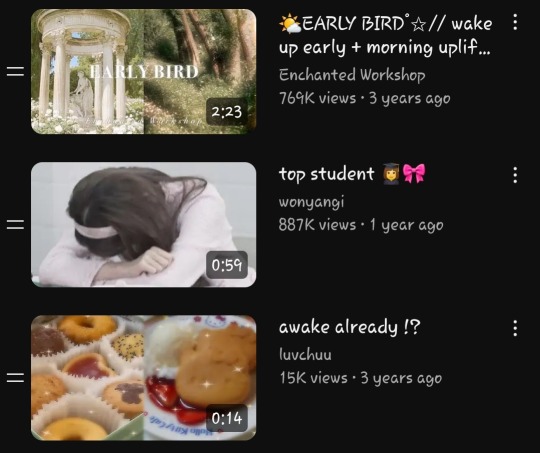
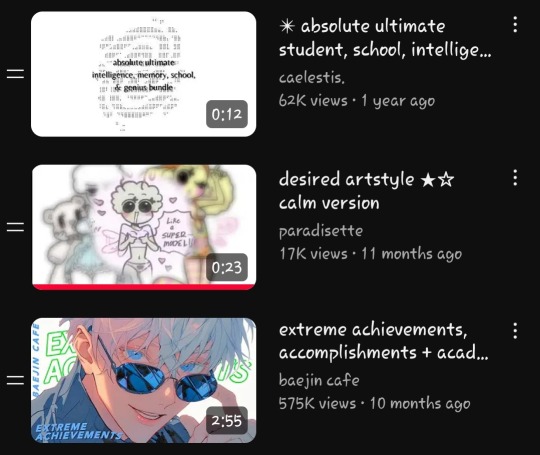
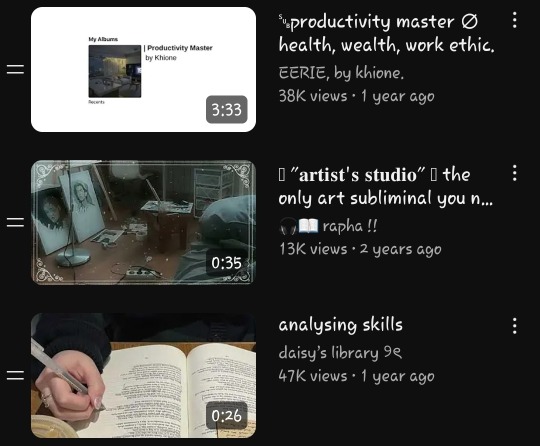
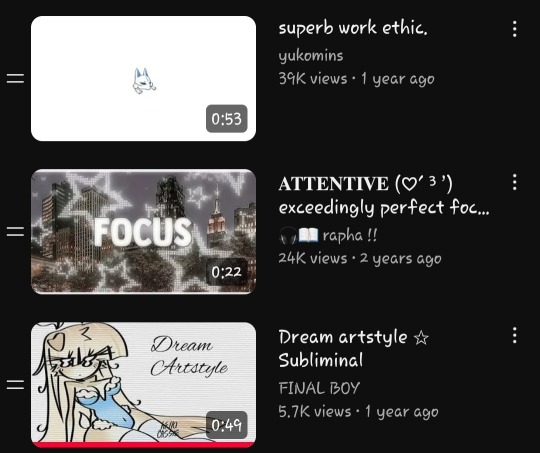
«───────── « ⋅ʚ♡ɞ⋅ » ────────»
"Ugh she is always doing the most with her work😒-" And she always looks good doing it. She's got the looks and the discipline; she's got it all
── .✦ ┆ 𖤐 ┆ ␥
|| Gorgeous, curly, and ideal (3B to 3C) hair. My hair never gets greasy, dry, breakage, damage, frizz, dandruff, or split ends. My curls are always moisturised, soft, bouncy, and defined. I never experience a bad hair day, and my hair is super easy to manage. Detangling my hair is a breeze, and styling my hair is even easier; every style looks exactly the way I want it and never loses the volume or shape throughout the day.
|| Ideal, fit, slim thick pear. Short shoulders, small ribcage, medium-sized chest, 20 inch waist, wide hips and slight dip, long legs, fat ass but not too fat, chubby but fit thighs, slimmer defined calves and small feet. The perfect pear. And every outfit looks exactly the way I want; I never look awkward but I always look put together and stylish.
|| Craziest face card. Ms. Face economy infact. I have a round heart shaped face with dark brown bambi eyes and long fluttery lashes, a medium straight nose bridge, plump pink "keyhole" lips, and the clearest, softest brown skin ever... Yet I still put make up on- yes I do because it's fun and I like it, so it's always awesome knowing I can do my make up flawlessly and nail my looks perfectly
Ex. Subliminals in my ideal appearance playlist
"3C hair type", "Pear body", "Desired face", "brown caramel skin"
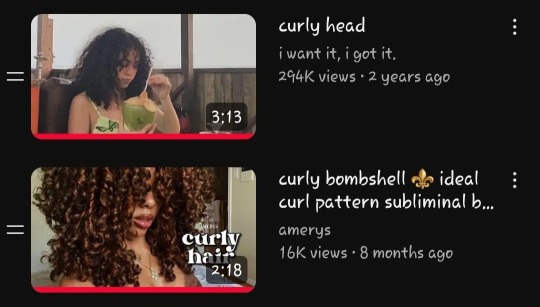
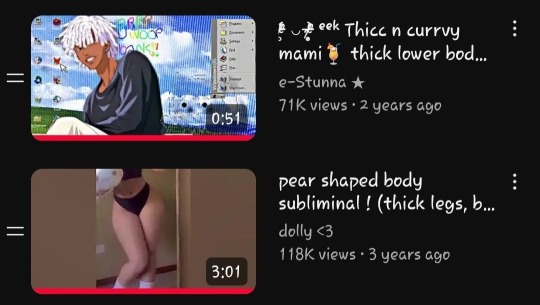
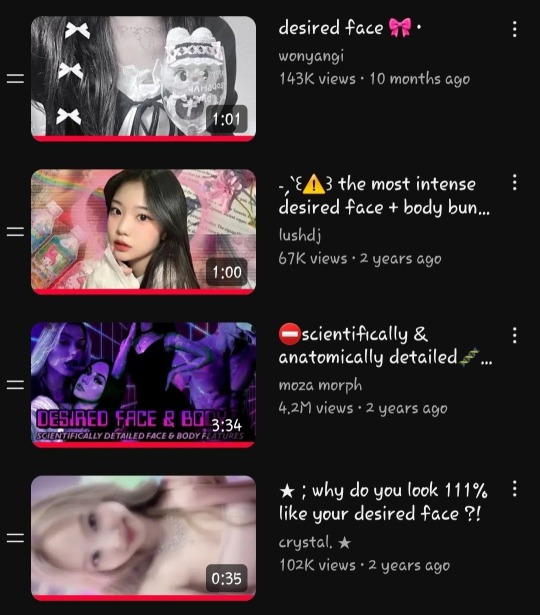
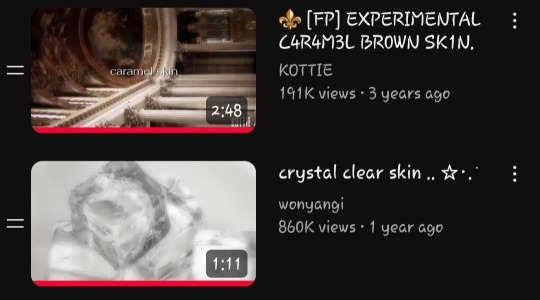
∘₊ ✧───────────────────✧₊∘
I'll probably add smore later :3 k bye
#martini yaps!#shiftblr#loa blog#loablr#desired reality#master manifestor#law of assumption#4d reality#desired self#desired appearance#desired life#desired body#dream life#shifters#shifting#loa
88 notes
·
View notes
Text
What I know from quietly mentoring women over the years is that most women do not need to eat less. We need to eat more, especially more protein, which stimulates our metabolism to become more active. Eating more protein is not necessarily about mindlessly eating and killing more and more animals, these sentient beings who clearly do not want to be eaten by us. It does mean finding more creative ways to get more protein in our meals by centering eating more things that do not have a central nervous system like eggs, plants, fruit, soaked nuts and seeds, and oysters, or reusing bones from homemade bone broth over and over and over again but not just absentmindedly buying more meat from anywhere and everyone. While vegetarian sources of protein are ok like well-soaked, well-cooked kidney beans yet not as dense and bio-available as animal sources especially as we get older (and our digestive systems get older ), we do have to be mindful and thoughtful around our eating habits that can cause us to reap more negative forms of karma. Karmic cycles follow those who don’t close out chapters of their lives properly and live recklessly with no honor, principles, or values. I would love to see more collective care and deep soul ritual around how we relate to and consume animals. In another life, I would be a homesteader and live with intention, prayer, playfulness, and ritual around my farm animals and their rites of passage.
And when there was a sacrifice that needed to be made, I would be the one to do it all as a daughter of Oshun and Artemis, while adorned in the most beautiful elegant cowrie shells and form-fitting, colorful fabric wrapped into a little dress and I would make the ethical kill with love, respect, and precision. Oftentimes this is a missing key code with women—to face and come to terms with death and our need to give death to what is no longer serving, like a long term friendship that no longer feels solid and truthful or a farm animal who constantly attacks and creates fights that injure other animals on the farm. Both scenarios are one in the same frequencies. —India Ame’ye
75 notes
·
View notes
Text
Happy National Zookeeper Week!
I’ll admit, I’m feeling a little spicy about it this year (well, every year) because zoos use the celebration for lots of positive facility PR, yet staff don’t often get the support and respect that is claimed in those posts.
So I want to share this great article written by a zoo industry consulting group last year looking at the reality of what happens when a workforce ends up conflicted between their passion (zoos and animals) and pragmatism (paying rent, existing in a capitalist society). They assessed AZA compensation rates by region against things such as a living wage and rental rates in the area. (All text formatting within quotes, such as bold and italics, is original to the article text.)
I cannot give the Canopy Group enough support for the way they framed this research:
“By observing the economics of keeper compensation, it’s no secret that keepers land on the lower end of the wage spectrum. Like all other wages and salaries, the market value of keeper compensation is driven by several economic factors – including the size of the labor pool, the rigor and danger of the work, the technical ability required, and the educational requirements. However, there is one factor that artificially lowers the market value of keeper compensation more than any other: passion.
In this article, we’ll take a look at why passion lowers the market value of animal care worker wages. More importantly, we’ll consider many factors that have emerged in recent years that are making people reevaluate the value of following their passion – a trend contributing to The Great Resignation, especially as it applies to zoos, aquariums, and similar organizations. (…)
The argument here is passion versus pragmatism: the unknown versus the sure thing. It is a decision all zookeepers and animal care technicians have made. Working with animals is immensely rewarding, but this passion is also very popular. This, historically, has meant that the keeper candidate pool is very large. Therefore, if the wage is livable and working conditions are reasonable, the pool should remain large. In a very real sense, a passion for animals drives down the market value of keeper compensation. Anyone who has been through an Economics 101 course will recognize this as a fundamental market principle: supply vs. demand.
However, many zoos and aquariums are having a more difficult time filling positions than normal and have started to see higher turnover rates in recent years. This begs the question – is the current keeper wage too low?”
Their findings?
Here’s their graph of “the median wage of keepers from organizations in different AZA-defined regions” from an AZA survey done in 2021. (Median is the type of average that looks at the middle of a data set’s range).
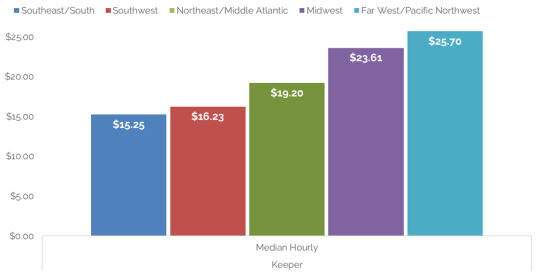
The median wage for AZA keepers in the South/Southeast was just over $15/hr at the low end, and the median wage for AZA keepers in the Far West / PNW was a little under $26/hr. That’s pretty dang low everywhere, especially when you factor in the increased cost of living in places like the West Coast. Also consider that looking at the median wage doesn’t mean this reflects just entry-level compensation - this data indicates the the compensation middle for all keeper positions, including people who have built their careers as keepers in those places long-term.
Then, they compared those wages to the “living wage” in each region - which they defined as “a calculation of what it takes to live in a particular area, without any other income. A living wage calculation takes into consideration how many earners are in a household, how many children are being supported, etc. The living wage includes the costs of all the basic items a household needs to be self-sufficient.”
“If you receive a wage for a job that is below the living wage, then you are essentially taking a negative net income. This is unsustainable for the long term, and essentially defines where wages start to exploit passion.”
Here’s a figure they provided using the MIT Living Wage Calculator showing the average living wage for each of the AZA regions. The chart on the left shows the living wage for a single person with no kids; the second, for two parents with two incomes and one child to support.
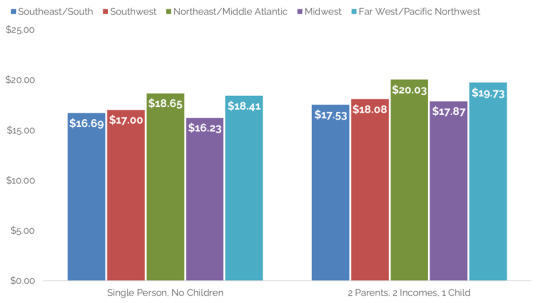
“By comparing the two graphs [to the earlier graph of the AZA median compensation rates], we find that median wages in the Southeast/South and Southwest regions are lower than the living wage for each household configuration in those regions. In other words, if you are a single person household or part of a two-income household raising 1 child in the South, a starting keeper salary will likely leave you with a negative net income. While many people work at this level, it increases the risk of accumulating debt, lowers a person’s ability to afford a home, set a much later retirement age, and can lead to many other negative, long-term effects.”
Big yikes, right?
Next, they looked at living wage vs. compensation for single parents.
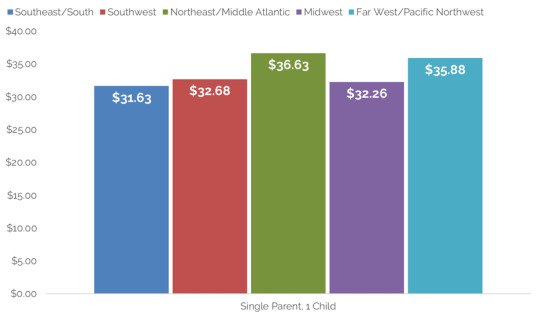
“The single-parent living wage exceeds the average keeper wage in all AZA regions. In fact, the living wage required as a single parent is double the average AZA keeper wage in some regions.”
And then they did housing, specifically, being able to purchase a home.
“In many places, even a two-income household at an average keeper salary would not purchase a mid-level home. This means that keepers have to wait far longer than their peers to purchase a home. While paying rent in the meantime, this rent will account for a larger portion of their income than their peers. All in, these effects can set hopeful homeowners back years or decades.”
Canopy’s conclusion was something anyone involved in the field knew was coming.
“Companies like Chipotle, McDonalds, Best Buy, FedEx, Home Depot, Publix, and Walmart are all offering similar starting wages near starting keeper wages – plus many fringe benefits (like tuition reimbursement) and ample advancement opportunities. Many potential keepers in younger generations are putting their passion on the shelf so they can meet basic standard-of-living concerns.
To attract and retain quality candidates, an organization must consider the journey each new employee would have to make over their career. If the journey is fraught with massive debt, decreased disposable income, and limited career opportunities, then you are limiting your potential candidate pool to the small group of people who have decided that following their passion is worth significant lifelong financial hardship. There are many potential candidates out there willing to sacrifice and arm and leg for animals and conservation, but they wouldn’t dare jeopardize the financial future of their dependents and families.”
This is something I’ve heard about for years, and seen first hand. The low average wage at zoological facilities has been damaging their ability to hire and retain skilled staff for as long as I’ve been involved in the industry. I know so many zookeepers who still have roommates into their 30’s, or work multiple jobs, just to be able to make ends meet.
There’s a mythology about zookeeping jobs, a narrative that seeps into the field and actively exploits people’s passion for the job: it tells people that they’re so lucky to be able to work with these rare and cool animals; that they’re greedy and ungrateful when they ask for more compensation because they’re privileged to get to have the job at all. It says that most people would give anything to have these opportunities, so current zookeepers are interchangable and easily replaceable. Ask for too much? Push for a living wage? There’s always someone willing to take your spot. Not all facilities perpetuate this mentality - some places do treat their staff well without intentionally manipulating them to stay them in unsustainable jobs, and there can be legitimate financial reasons that limit staff compensation (mostly at smaller facilities, afaik) - but it’s a reality in the field.
For a long time, this type of mentality towards staff was sustainable. There really were always more people wanting to work in the field. But now, after three years of pandemic stressors and inflation, it’s starting to be a problem. A lot of staff left during the last few years, and facilities are having a really hard time hiring people and retaining them for any duration. I think a large part of that is low compensation rates. People are prioritizing long-term financial stability and recognizing when their passion is being exploited.
When I first started on tumblr back in 2011, there was a whole group of us within the United States who were baby zookeepers or volunteering as industry hopefuls. We all became friends, and I’ve stayed in touch with, or at least aware of, most of them as their careers progressed. Of the 10-15 or so people in that cohort? I can think of three who are still employed in the zoo industry. Everyone else has moved on into other fields - often with great grief over the loss - because of the extreme emotional labor, the physical exhaustion, and the lack of appropriate compensation.
But I guess that annual pizza party, being featured on social media, and maybe getting additional snacks all week makes up for it all?
#national zookeeper week#zoo industry#living wage#compensation#please support your local zookeeper#AZA accreditation#AZA zoos#zoos
556 notes
·
View notes
Text
My OCs' jersey number explanations ramblings ^_^
Tsubasa - #13 (usual jersey)
Tsubasa's birthday is February 13. So purely in terms of personality, Tsubasa is egocentric and self-absorbed enough to use his birth date as his preferred jersey that he insists on wearing
Now onto the meta stuff:
Well we all know 13 is the cliched bad luck number in Western culture. Tsubasa in his backstory has many unlucky circumstances surrounding his life. Btw I know Gesner is #13 in BM but let's be honest Tsubasa is more important (my beloved oshi). I think it can also have a double meaning, unlucky number 13 as in you're unlucky to be against him rather than the sole fact that he, himself, is unlucky.
Tsubasa is a self-reliant person & player who always preserves so it can be a case of someone "making their own luck" no matter the circumstance as well.
He has a lot of strange beliefs and conventions so being symbolized by a superstitious number also fits him thematically. For example he believes in angels and the death-rebirth cycle and other such not scientifically proven to exist things.
Tsubasa's character has a theme surrounding an obsession with "death" both literal and symbolic (as his goal of self-realization and also his definition of "change" lies in "death" in his own mind, hence the obsession with "dying", and to him "death" is "repentance" for what he "has done", which according to him is "being born").
The death-rebirth cycle samsara is a Buddhist belief. In Japanese beliefs about Buddhist deities, there are thirteen Buddhas who also play an important role in traditional funerals (once again bringing it back to the theme of death and rebirth in his own personal belief system + as well as the fact that he veers spiritual).
The number 13 itself in astrology and tarot readings is sometimes associated with transformation and rebirth, and the End of one cycle onto the beginning of another. The "Death" card is number 13 in the major arcana - the card itself also symbolizes renewal.
In Japanese & Chinese numerology: 1 + 3 = 4, "shi" = death, traditonally four is considered unlucky in Japanese culture even if 13 itself isn't.
#42 - U-20 match jersey specifically
4 + 2 = "shini" = "to death", again considered an unlucky number, in Tsubasa's case more so means "I'll play to death", i.e. "I'll play until I'm renewed". It's also pretty edgy and contrarian all things considered since a superstitious Japanese person would usually avoid having this as a jersey number.
Mael - #5
Mael's jersey number as well as most things about him are meant to be ironic in some way/bully him.
In Japanese numerology, it's considered a lucky number. It's also associated with the Chinese concept of the "five elements"/Wuxing, so it is said sometimes that number 5 brings luck and blessings, which Mael lacks from birth.
The deficient destructive cycle in Wuxing is the fifth phase "counteracting" (fire evaporates water, water destabilizes earth, etc) -> Mael has a reactive and explosive personality that is harmful to him and others lying within his trigger prone behavior.
In Christian numerology, number 5 symbolizes grace and God's unwavering love towards humankind, which is again ironic because Mael is born in an unfavorable situation and struggles to move on.
God's fifth commandment is "Honor your mother and your father" -> Mael was born into an abusive household to drug addicts who neglected him and later on disowned him. Since birth they gave him nothing and were nobodies to him. Number 5 symbolizes God's favor culturally, but Mael was not born in his favor, and afterwards he fails to adjust to a normal and stable self and living.
In Buddhism there are also five precepts that serve as the base morality principle for enlightenment and the path so salvation.
The five precepts forbid the following: killing of both animals and humans, theft and other things along those lines (fraud, forgery), sexual misconduct (i.e. sexual acts which are either forceful, unethical or adulterous in nature), spoken falsehood (lying, gossiping, verbal aggression), intoxication (alcohol, drugs, occasionally smoking is counted).
Out of those Mael is guilty - and often! - of theft, verbal aggression/malicious speech, intoxication (both as someone who uses stimulants and drinks frequently and even sold substances in the past).
TL;DR MAEL IS NOT MAKING IT TO NIRVANA WITH THIS ONE 😂😂😂 HE IS STUCK IN THE CYCLE 😂😂😂😂
36 notes
·
View notes
Note
idk how but you draw in the Oso-san style so good i need to know your secret please
HAHA thank you very much!! im glad you think so :D unfortunately im not very good at explaining how i work, but ill try my best to show what i mean!!
once again this is long as hell. you know the drill at this point
to be honest, half the battle i fight with drawing in the osmt style is just. Looking at it. the ososan art style actually fluctuates pretty wildly depending on what you're looking for, whether that be the mobile games (for instance, tabimatsu and hesowars look nothing alike in terms of style despite both being the same source material), official art and merch, or even the seasons of the show itself!
using ichi as my example here since i draw him the most, but its pretty easy to play spot the difference with the varying styles. even within a specific season you can do this across episodes, especially with season 1!

when i draw, i tend to be a bit sacrilege and use references across different media; usually ill use the show [especially season 2, if only because its a bit more "uniform"] as reference for the actual features and colors/poses/etc, but i like to use hesowars to reference proportions, since they seem to be most consistent there.
SOMETHING IMPORTANT TO NOTE: theres a WEALTH of fanartists that have styles that are INCREDIBLY similar to the show, so be careful to check your sources! these artists deserve credit for their hard work, which they often don't get since their work is reposted under the guise of being official art.

once you've pinned down the exact style you'd like to emulate, and the character you're looking to draw, its really just a matter of finding references, which is pretty easy! you can scrub through different episodes for good angles/shots, or if you're going for one of the game styles the AU wiki has most of the games catalogued to my knowledge. if you're looking to draw an oc, use characters you think they would look similar to in the show. if you really wanna waste your time, though, you can always scrub through crowd scenes in the show to see if any background characters might look like what you're going for; the season 3 episode Mt. Takao comes to mind, there were a lot of cute mob characters there.
using keiko as my example here, you can see that i pulled her features from multiple different characters to get her to look right in the style. with ocs, its important to reference a number of different characters, since the likelihood of a background character being a 1:1 for your little guy is unfortunately pretty low. there WILL, however, be a lot of characters that look KIND of like them. the key is to figure out what parts go where!
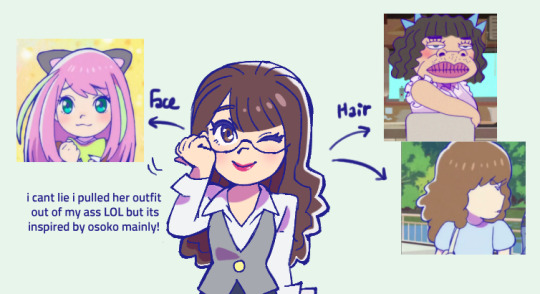
to this point, most prominent ososan women have very similar stock anime girl faces with very minor differences, so if youre looking to make a cute girl oc, most of the womens' faces can be used somewhat interchangeably. if you want your cute girl oc to have a more unique face, though, the movie gave us some women with more unique faces in the form of the NEETs' old classmates! theres also no harm in referencing male characters faces in this regard. #butchswag #kiruminikuya
BUT. going back to the assumption that you're drawing a canon character, today I'll be drawing oso for my example
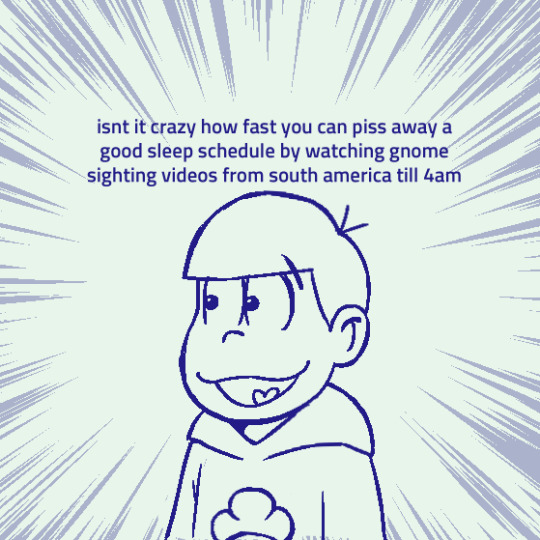
when you're first getting a feel for the style, tracing some of your references can actually be a really great way to acclimate yourself to the characters proportions and features. think of like when you were a kid, and would trace over pictures of pokemon or cartoon characters so you could draw them better. its basically the same principle! this was especially helpful for me when it came to eyes; they vary the most wildly of any other trait that characters have in ososan, so going over the different shapes to get a feel for each of them was very important.
when you trace, though, I recommend doing so a bit more loosely, sort of like if you're doing a photo study for anatomy; block out the basic shapes and do small markers for different features (i.e small lines to denote where the eyes start and and, distance from nose to mouth, things like that), and from there draw the rest on your own.
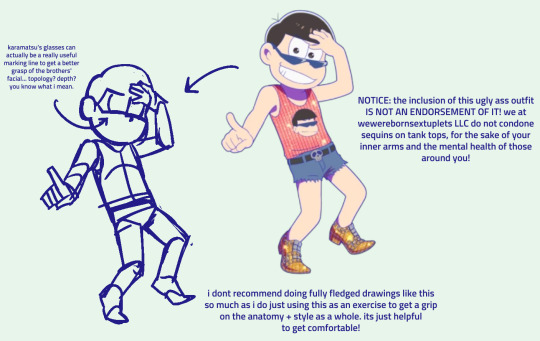
after long enough you'll get a feel for the basic placement of where everything should go! the eyes and nose are undoubtedly the hardest when it comes to the sextuplets, since they shift around a LOT between games/seasons/etc. so don't feel bad if you have a hard time with that, since there isnt really a "right" answer with how frequently it changes. i still fuck it up all the time myself!

as for some basic tips, heres some stuff i try to keep in mind when drawing them that just helps the finished product look a bit nicer!

when drawing the hair + fringe line, its important to swoop it downwards a little bit; the flat across look Can work, but if you're not careful you risk showing the tops of their eyes, which is um. ew! ick! nast!
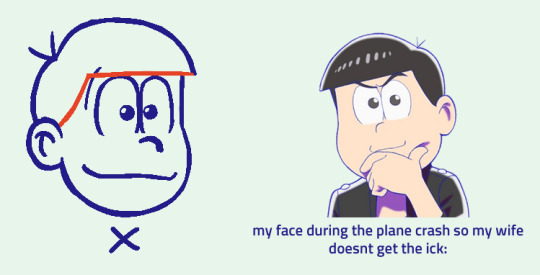
when a matsu is facing forward, their hair will usually tend towards one direction to keep the silhouette. in most screenshots i saw, the bowl cut points left! that said, dont be afraid to point rightwards if its better for your specific drawing!
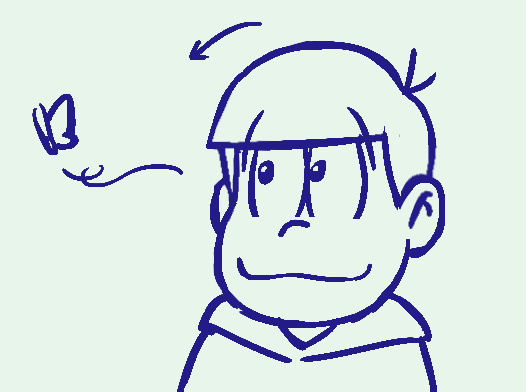
and lastly: USE THE LIQUIFY TOOL. LIBERALLY. i am not joking when i say this has saved my ass so many times, its hard to get the placement right on the facial features and even harder to get everything to LOOK good, so if its available to you i HIGHLY suggest just squishing everything around with a liquify tool until it looks right. you can always go back and correct the blurry lines. its really a life saver
BUT YEAH! i dont know if this was very helpful but i hope you're at least able to gain something from it :-))
80 notes
·
View notes
Text
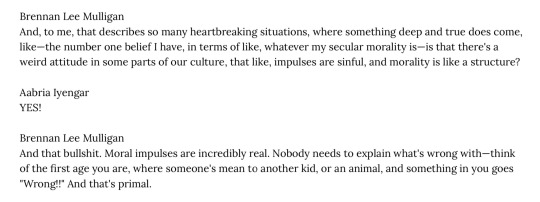

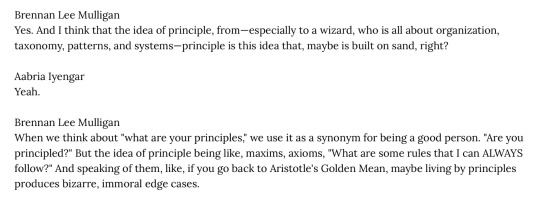


Brennan Lee Mulligan during the fireside chat for The Wizard, The Witch, and The Wild One - Episode 9
[Image ID:
Screenshots of excerpts from the transcript of the Worlds Beyond Number podcast’s fireside chat on The Wizard, The Witch, and The Wild One - Episode 9.
Brennan Lee Mulligan: And, to me, that describes so many heartbreaking situations, where something deep and true does come, like- the number one belief I have, in terms of like, whatever my secular morality is— is that there's a weird attitude in some parts of our culture, that like, impulses are sinful, and morality is like a structure?
Aabria Iyengar: YES!
Brennan Lee Mulligan: And that bullshit. Moral impulses are incredibly real. Nobody needs to explain what's wrong with-think of the first age you are, where someone's mean to another kid, or an animal, and something in you goes, "Wrong!!" And that's primal.
[…]
Brennan Lee Mulligan: And like it's-it's brutal! It's very Imperial. It's like this oppressive weight, from a very smart opponent, who is convincing themselves. Like, the reason the arguments have that urgency, is that Suvi is also self-indoctrinating, and it's part of that thing that comes back up. And I think the big, sinister part of, of….. The idea of principle. Like, what, in principle, is different from a demon being bound in a circle of salt, and what you saw happening to Naram out under the derrick. This is-I don't have time to explain this in this talk back. I have issues with the philosophic concept of principle, point blank.
[…]
Brennan Lee Mulligan: Yes. And I think that the idea of principle, from-especially to a wizard, who is all about organization, taxonomy, patterns, and systems-principle is this idea that, maybe is built on sand, right?
Aabria lyengar: Yeah.
Brennan Lee Mulligan: When we think about "what are your principles," we use it as a synonym for being a good person. "Are you principled?" But the idea of principle being like, maxims, axioms, "What are some rules that I can ALWAYS follow?" And speaking of them, like, if you go back to Aristotle's Golden Mean, maybe living by principles produces bizarre, immoral edge cases.
[…]
Brennan Lee Mulligan: So it's this idea of, like-but it's unexamined by Suvi in that moment, and the reason it's unexamined, is because I think it's one of the main tools of the indoctrination of the Empire. What have you already accepted? Right? I see this in ethical discourse all the time, which is why whataboutism is so powerful, in modern philosophical discourse, is people go like, "Okay. You've made a moral point. You've made a call to action. You've said, 'we need to do something to make the world better.' So what I'm going to do is find some other moral failing of yours, hold it up in front of you and say, 'but you did this bad thing like this,' or this other situation occurred that was similar to this, where you did not act. So wouldn't you in fact, be a hypocrite by acting or not acting in a similar way this time?'''
Brennan Lee Mulligan: Which sounds, when you see it in the world, like sound moral reasoning, and it's garbage.
Taylor Moore: [Laughs]
Brennan Lee Mulligan: Because it's basically saying, like, "Instead of helping, why don't you be consistent?" And it's like-
[…]
Brennan Lee Mulligan: It's like stupid. What the fuck is the point of consistency? Like principle as a measurement of consistency, and the Fox's whole deal would be like, "Yeah, yesterday I did something bad and today I'm going to do something good because I want to." That's all.
Erika Ishii: Yeah.
Brennan Lee Mulligan: And someone would be like, "You're a hypocrite." And he'd be like, "Okay! I'm gonna get some fish slurry."
End ID.]
#brennan lee mulligan#worlds beyond number#the wizard the witch and the wild one#THIS!!!!#fuck your principles#riah.img
78 notes
·
View notes
Note
acting like you’re some woke person just because you advocate for middle aged women to be lifeless on the internet is not the flex you think it is 💀
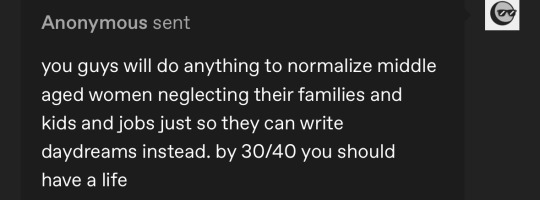
You seem rather passionate about this so I’m going to indulge your ask to let you know three things:
Writing is a hobby that gets better with age, life experience, and practice. The best pieces of writing objectively come from older people and I’m not talking about fanfiction. I mean books and literature. I’m serious—go look at some of the most well known pieces of literature and then search up the ages of their authors during the years they were published. You’ll find the older writers tend to bust out bangers and this principle is very much applicable to fics too by default. Also writing fanfic is not “lifeless” lol. Some of you act like writing fanfic is juvenile compared to a novel and it’s rly not that different from writing an original piece of fiction. Sure, sometimes fanfic can be a little less on the conventional side in terms of technique. But genuinely the concept of putting characters into situations to create a plot is literally the main thing on both sides here and if you think writing fanfic is silly, it makes 0 sense to hold creative writing to some pedestal. Some fanfic writers demonstrate AMAZING original world building skills especially if they write au’s that diverge from canon and I think you are out of your mind if you think this hobby is not oftentimes an impressive one rather than “lifeless”
Being 30+ doesn’t automatically mean you must/do have a family and kids but I’ll still indulge that point and say you can easily balance a work and personal life while also having a hobby. I know middle aged men who dedicate more time to hobbies like hunting and fishing than middle aged women do with writing. One actually requires you to leave your house and family behind and the other you can do from the comfort of your home and tend to your family should you need to. I think the nature of your opinion only stems from a misogynistic view on aging women but that’s another can of worms
People don’t stop consuming and enjoying things as soon as they hit their third decade of living. If that’s your viewpoint on life, you’re going to set yourself up for a very miserable time once you hit 30. If you’re already 30+ then you’re a hypocrite by default by even being here in the first place lol. Also, life is literally so fucking silly okay? You wake up, work, pay taxes, and try to get by with what is usually an underpaid paycheck. Just fucking enjoy your life and let others enjoy theirs okay? If a 30 year old likes anime, then that is literally so god damn harmless I cannot stress enough how unimportant that is. There are 30 year olds out there doing heinous things in their free time and you choose to be bothered by someone who happens to produce an assortment of words from time to time. Please reevaluate your priorities
All things aside I cannot convince you that being 30+ and enjoying fandom and fanfic is not weird unless you really just realize that it’s not weird. Idk how old you are but I assume you’re younger than 30 because no 30 year old would be on fandom tumblr and then bash others for it. But regardless, just because you think something is weird doesn’t mean it’s bad. It is literally the most harmless thing I do not understand why you would care so much, just move on???? When you think someone dresses weird in real life do you go point it out to them??? No you think it to yourself and move tf on—and if you would voice it to them then you are literally a rude individual. Plain and simple. Rude and disrespectful and I would suggest you again, reevaluate. And it’s the same principle here. You just move on. If you seriously cannot be convinced that this is normal and just absolutely are dead set on believing that 30+ year olds who enjoy fandom are weird, fine. But just keep it to yourself it is the bare minimum you can do to be a decent person I cannot stress this enough to you
And one more thing. The people who are writing the mangas and animes you enjoy so much are middle aged. Older than 30/40. Grown people who might even have families and kids. Creativity has no age limit it is just a small joy that people indulge in at any age and it’s a very nice thing when they share it for others to enjoy, as well. Please just enjoy someone’s art and live a little. I promise you will be much happier and peaceful if you just read a good fic without worrying about the age of whoever produced it. I guarantee you a lot of the BEST fics you’ll read will come from the older writers they are literally doing you a favor if you happen to enjoy reading fanfic. Why bite the hand that feeds you?
#my asks#i really didn’t want to answer this because I think this ask#was sent with the intention to get a reaction#however I think that in general a lot of you view fanfiction as a juvenile thing to enjoy/partake in#therefore you think that older people who participate in the consumption/creation of fanfic are also juvenile/weird#and I think you should really abandon that opinion unless you think creativity as a whole is something that is meant for people in their 20#your opinion seriously becomes applicable to most creative outlets and then you essentially strip 30+ year olds of creativity as a whole#and that is just a very weird way of viewing the world idk#I would suggest being a little less uptight about fun and it’s so called constraints
31 notes
·
View notes
Text
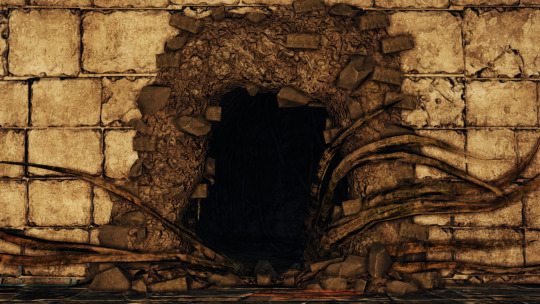
Something that I've been anticipating lately is a renewed appreciation for FromSoftware's post-King's Field "medievalist" releases which de-emphasize speed and spectacle; that is, Demon's Souls, Dark Souls, and Dark Souls 2.
I'm a little surprised that there hasn't been much commentary on the gradually diverging artistic shift we can track from Demon's Souls to Elden Ring. Mostly, the discursive possibilities have been limited to remarking upon whether or not Elden Ring is "too hard" relative to some earlier title. This focus on design has tended to occlude observations on the aesthetic consequences of a divergence.
In a variety of ways, Elden Ring is not only (in an abstract, although probably very often also in an actual, sense) a much harder game than Demon's Souls; it also represents something of the upper limit of a type of grandiosity of combative expression, whether that has to do with a boss' design or the capabilities of our avatar. Were we to be dismissive, and maybe a little culturally reductive, we could use the term "anime" for critical shorthand when describing how one of Shadow of the Erdtree's bosses has a magical sword attack that encompasses the entire space of a fairly large arena.
On the one hand, Elden Ring represents a sensible evolutionary point of a mechanical foundation established by Demon's Souls. On the other hand, Rellana's courtyard-sweeping attack, and other things, like very nearly anything to do with the second phase of the DLC's final boss, are the sort of stuff I joked about as an inevitability after finishing Dark Souls 3's DLC. Pretty much any major opponent from Dark Souls and its sequel seems like a quaint, jerky windup toy when compared to Elden Ring's bosses.
I wonder, though, if that relative restrictiveness won't come to be newly valued for the differentiation it represents internally to these games -- perhaps most visibly with Dark Souls 2, which not too soon after its release, and ever since, has tended to be spoken of as an outcast in need of either a dunking or a defense, or has confused people obsessed with ranking their media diet. It's highly unusual that Dark Souls 2's development team would decide to make a game which is more slow and methodical than its two forebears. This is a very uncommon progression -- so uncommon that a lot of people would, I am sure, consider it to be a regression. But, perhaps, we now have an opportunity to see this slowness with different eyes.
In a previous post, I wrote, of Shadow of the Erdtree:
There’s a lot of good level design to be found here among the dungeons, castles, and forts, yet the abundance and enormity of it all seems to have deprived the game of significant contrasts, and those special spatial moments, which I found much easier to locate and reflect upon with, say, Dark Souls or Bloodborne. Sure, the sky-piercing spiral of Enir-Ilim is a sight to behold; but soon enough the sequences of grand staircase upon grand staircase, great bridge upon great bridge, creates a perpetual climatic grandiosity that diminishes the very effect of a climax.
This "climax fatigue" is similarly applicable to Elden Ring's weapons, a good number of which have some dramatic, slick, or acrobatically superhuman secondary function. Whereas Dark Souls has almost no obviously "cool" weapons, most being within a range of utilitarian swords, maces, clubs, and spears, Elden Ring has so many superlative offensive items and skills that, after a while, these flourishes become lost among a fantastical morass of melodramatic aesthetics. And whereas Demon's Souls is undeniably much simpler when compared to Elden Ring, there is something satisfying about the older, "inelegant" design where you can feel the proximity to the dungeon crawler sensibility: blunt, rough, and chunky.
The recently unveiled Nightreign would appear to represent one kind of developmental compartmentalization at FromSoftware between more frequently released offshoots and principle works with longer developmental cycles. I'm curious if it might not also represent a forthcoming differentiation between the faster, more spectacular type of gameplay and a slower, less flashy type of gameplay which may be calling back to Miyazaki after years of an intensifying emphasis on the big and bold "anime" side of things.
25 notes
·
View notes
Text
The spectrum of sports anime runs from Near Realism to Firmly Removed From Reality.
On one end of this spectrum we have Haikyuu!! which wins over every other sports anime in terms of actually being about the sport. Every part of Haikyuu!! is either playing a match or preparing for a match and almost all of their abilities and plays are firmly rooted in reality. Is it perhaps slightly unrealistic that this one short guy can jump That High??? Maybe, but he IS a shounen battle protagonist (haikyuu follows the shounen battle format perfectly Do Not At Me about this I am Right. The battles are matches. Obviously.) and therefore Hinata being Just That Good and Kageyama being Just That Good is necessary for genre reasons.
On the opposite end of the spectrum is something like Birdie Wing, the lesbian golf mafia anime, which I have not seen yet (yet!!! It is on the docket!) but I did watch this video essay about it and I think Geoff Mother’s Basement Thew would agree with my assessment. Which is to say that it’s absolutely batshit off the wall wild and has very little in common with the actual sport of golf. Which is great for me personally, because fuck golf.
Somewhere in between these two extremes lies Sk8 the Infinity which at first seems to maybe have some solid grounding in actual skateboarding and snowboarding technique and jumps even if it is unrealistic that they manage to be mostly fine after high speed crashes with no protective gear, and then fucking Adam shows up and drags the genre towards absurdity until it culminates in a psychic skateboarding battle to the death.
In our universe entering a flow state is something that anyone who is really comfortable with an activity can do, where you are basically embodying the mindfulness principle of One Mind, perfectly aware of everything related to your task and able to act without thinking about it first, in what’s basically a moving meditative state.
In the sk8 universe entering a flow state means getting mentally sucked through a prismatic vortex into a hypnotic paralysis which can be induced by one crazed matador roleplayer pulling you into basically a vampire thrall and can only be broken with the power of love friendship.
#sk8#sk8 the infinity#haikyuu!!#birdie wing#animanga#sports anime#caitie speaks#I am once again asking people to watch mothers basement videos#have I mentioned how he’s the only way I get anime recommendations#every good show I have watched except for maybe Given??? resulted from a mothers basement recommendation#the thing about haikyuu following battle shounen formula is from his haikyuu video which is the video that convinced me to watch haikyuu!!
177 notes
·
View notes